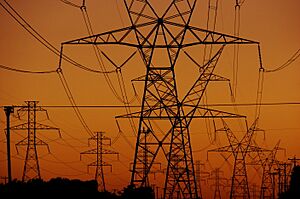Catenary facts for kids
In physics and geometry, a catenary is a special curve that a perfectly hanging chain or cable makes. Imagine a rope hanging freely between two points, supported only at its ends. The U-shaped curve it forms is a catenary.
Even though it looks a bit like a parabola, it's not the same! The catenary is actually a graph of a special math function called the hyperbolic cosine. You can also see this curve in some arches and as the shape of a catenoid, which is what a soap film looks like when stretched between two parallel rings.
The catenary is also known by other names like alysoid or chainette.
Understanding the Catenary Curve
The catenary curve is a graph of the hyperbolic cosine function. If you spin a catenary curve around, it creates a 3D shape called a catenoid. This catenoid is a "minimal surface," meaning it's the shape that uses the least amount of surface area for its boundaries.
Scientists have studied the catenary for a long time. Robert Hooke first looked into its math in the 1670s. Later, in 1691, mathematicians like Leibniz, Huygens, and Johann Bernoulli figured out its exact equation.
Where Do We See Catenaries?
Catenaries are very useful in architecture and engineering. They are used when designing bridges and arches. This is because the catenary shape helps spread forces evenly, making structures strong and preventing them from bending or breaking.
For example, electric power cables hanging between poles often form a catenary curve. In the offshore oil and gas industry, long pipelines that connect oil platforms to the seabed also hang in an approximate catenary shape.
The word "catenary" comes from the Latin word catena, which means "chain."
Images for kids
-
Antoni Gaudí's catenary model at Casa Milà
-
Simple suspension bridges are essentially thickened cables, and follow a catenary curve.
-
Stressed ribbon bridges, like the Leonel Viera Bridge in Maldonado, Uruguay, also follow a catenary curve, with cables embedded in a rigid deck.
-
A heavy anchor chain forms a catenary, with a low angle of pull on the anchor.
-
Golden Gate Bridge. Most suspension bridge cables follow a parabolic, not a catenary curve, because the roadway is much heavier than the cable.
-
The Sheffield Winter Garden is enclosed by a series of catenary arches.
-
The Gateway Arch (St. Louis, Missouri) is a flattened catenary.
See also
 In Spanish: Catenaria para niños
In Spanish: Catenaria para niños












